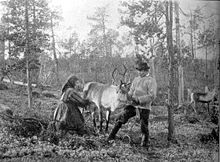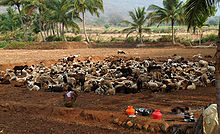- Nomadic pastoralism
-
Nomadic pastoralism is a form of agriculture where livestock are herded in order to find fresh pastures on which to graze following an irregular pattern of movement - in contrast with transhumance where seasonal pastures are fix.[1] The herded livestock may include cattle, yaks, sheep, goats, reindeer, horses, donkeys or camels, or mixtures of species. Nomadic pastoralism is commonly practised in regions with little arable land, typically in the developing world. Of the estimated 30–40 million nomadic pastoralists worldwide, most are found in central Asia and the Sahel region of West Africa. Increasing numbers of stock may lead to overgrazing of the area and desertification if lands are not allowed to fully recover between one grazing period and the next. Increased enclosure and fencing of land has reduced the amount of land available for this practice.
Contents
Origin
Nomadic pastoralism was a result of the Neolithic revolution. During the revolution, humans began domesticating animals and plants for food and started forming cities. Nomadism generally has existed in symbiosis with such settled cultures trading animal products (meat, hides, wool, cheeses and other animal products) for manufactured items not produced by the nomadic herders.
Historically nomadic herder lifestyles have led to warrior-based cultures that have made them fearsome enemies of settled people. Tribal confederations built by charismatic nomadic leaders have sometimes held sway over huge areas as incipient state structures whose stability is dependent upon the distribution of taxes, tribute and plunder taken from settled populations.[2]
In the past it was asserted that pastoral nomads left no presence archaeologically but this has now been challenged[3] Pastoral nomadic sites are identified based on their location outside the zone of agriculture, the absence of grains or grain-processing equipment, limited and characteristic architecture, a predominance of sheep and goat bones, and by ethnographic analogy to modern pastoral nomadic peoples[4] Juris Zahrins has proposed that pastoral nomadism began as a cultural lifestyle in the wake of the 6200 BC climatic crisis when Harifian hunter-gatherers fused with Pre-Pottery Neolithic B agriculturalists to produce a nomadic lifestyle based on animal domestication, developing a circum-Arabian nomadic pastoral complex, and spreading Proto-Semitic languages.
Nomadic pattern
Often traditional nomadic groups settle into a regular seasonal pattern, which has been described by some anthropologists as a form of transhumance. An example of a normal nomadic cycle in the northern hemisphere is:
- Spring (early April to the end of June) — transition
- Summer (end of June to late September) — a higher plateau
- Autumn (mid-September to end of November) — transition
- Winter (from December to the end of March) — desert plains
The movements in this example are about 180 to 200 km. Camps are established in the same place each year; often semi-permanent shelters are built in at least one place on this migration route.
In sub regions such as Chad, the nomadic pastoralist cycle is as follows:
- In the rainy season, the groups live in a village intended for a comfortable stay. The villages are often made of sturdy material as clay. Old men and women remain in this village when the other people move the herds in the dry season.
- In the dry season, the people move their herds to southern villages with a more temporary character. They then move inland, where they stay in tent camps.
In Chad, the sturdy villages are called hillé, the less sturdy villages are called dankhout and the tents ferik.[5]
By contrast, pastoral nomads follow a seasonal migratory pattern which varies from year to year depending on grazing needs. Such nomadic societies create no permanent settlements, but live in tents or other movable dwellings the year round. Pastoralist nomads are often self-sufficient, producing their own food, shelter and other needs.
Nomadic pastoralism around the world
Nomadic pastoralism was historically widespread throughout less fertile regions of Earth. It is found in areas of low rainfall such as the Arabian Peninsula inhabited by Bedouins and Northeast Africa inhabited by Somalis. Nomadic transhumance is also common in areas of harsh climate, such as Northern Europe and Russia inhabited by the indigenous Sami people, Nenets people and Chukchis.
There are an estimated 30-40 million nomads in the world.[6] Seminomadic pastoralists and pastoral nomads form a significant but declining minority in such countries as Saudi Arabia (probably less than 3%), Iran (4%), and Afghanistan (at most 10%). They comprise less than 2% of the population in the countries of North Africa except Libya and Mauritania. [7]
The Mongols in what is now Mongolia, Russia and China, and the Tatars or Turkic people of Eastern Europe and Central Asia were nomadic peoples who practised nomadic transhumance on harsh Asian steppes. Some remnants of these populations are nomadic to this day. In Mongolia, about 40% of the population continues to live a traditional nomadic lifestyle.[8]
In the Middle Hills and Himalaya of Nepal, people living above about 2,000 meters practice transhumance and nomadic pastoralism because settled agriculture becomes less productive due to steep slopes, cooler temperatures and limited irrigation possibilities. Distances between summer and winter pasture may be short, for example in the vicinity of Pokhara where a valley at about 800 meters elevation is less than 20 km. from alpine pastures just below the Annapurna Himalaya, or distances may be 100 km or more. For example in Rapti zone some 100 km west of Pokhara the Kham Magar move their herds between winter pastures just north of India and summer pastures on the southern slopes of Dhaulagiri Himalaya. In far western Nepal, ethnic Tibetans living in Dolpo and other valleys north among the high Himalaya moved their herds north to winter on the plains of the upper Brahmaputra basin in Tibet proper, until this practice was prohibited after China took over Tibet in 1950-51.
The nomadic Sami people, an indigenous people of northern Finland, Sweden, Norway, and the Kola Peninsula of Russia, practise a form of nomadic transhumance based on reindeer. In the 14th and 15th century, when reindeer population was sufficiently reduced that Sami could not subsist on hunting alone, some Sami, organized along family lines, became reindeer herders. Each family has traditional territories on which they herd, arriving at roughly the same time each season. Only a small fraction of Sami have subsisted on reindeer herding over the past century; as the most colorful part of the population, they are well known. But as elsewhere in Europe, transhumance is dying out.
The Mesta was an association of sheep owners, (Spanish nobility and religious orders) that had an important economic and political role in medieval Castile. To preserve the rights of way of its transhumant herds through cañadas, the Mesta acted against small peasants.
In Chad, nomadic pastoralists include the Zaghawa, Kreda, and Mimi. Farther north in Egypt and western Libya, the Bedouins also practice pastoralism.
Cross-Border Pastoralism
Sometimes nomadic pastoralists move their herds across international borders in search of new grazing or for trade. This cross-border activity can occasionally lead to tensions with national governments as this activity is often informal and beyond their control and regulation. In East Africa, for example, over 95% of cross-border trade is through unofficial channels and the unofficial trade of live cattle, camels, sheep and goats from Ethiopia sold to Somalia, Kenya and Djibouti generates an estimated total value of between US$250 and US$300 million annually (100 times more than the official figure).[9] This trade helps lower food prices, increase food security, relieve border tensions and promote regional integration.[9] However, there are also risks as the unregulated and undocumented nature of this trade runs risks, such as allowing disease to spread more easily across national borders. Furthermore, governments are unhappy with lost tax revenue and foreign exchange revenues.[9]
There have been initiatives seeking to promote cross-border trade and also document it, in order to both stimulate regional growth and food security, but alo allow the effective vaccination of livestock.[9] Initiatives include Regional Resilience Enhancement Against Drought (RREAD), the Enhanced Livelihoods in Mandera Triangle/Enhanced Livelihoods in Southern Ethiopia (ELMT/ELSE) as part of the Regional Enhanced Livelihoods in Pastoral Areas (RELPA) programme in East Africa, and the Regional Livelihoods Advocacy Project (REGLAP) funded by the European Commission Humanitarian Aid Office (ECHO).[9]
See also
References
- ^ Blench, Roger (2001). Pastoralists in the new millennium. FAO. pp. 11–12. http://www.odi.org.uk/work/projects/pdn/eps.pdf.
- ^ Lerro, Bruce (2006) "Power in Eden: the emergence of gender hierarchies in the ancient world" (Trafford)
- ^ Cribb, R (1991) Nomads in Archaeology. Cambridge University Press. Cambridge.
- ^ Oriental Institute of Chicago "Nomads, Tribes, and the State in the Ancient Near East: Cross-Disciplinary Perspectives".
- ^ Tsjaad by Dorrit van Dalen
- ^ NOMADS - The FACTS
- ^ Dale Eickelman, The Middle East and Central Asia. An Anthropological Approach. Fourth Edition. Prentice Hall, 2002, p. 11
- ^ Mongolia Today - online magazine
- ^ a b c d e Pavanello, Sara 2010. Working across borders - Harnessing the potential of cross-border activities to improve livelihood security in the Horn of Africa drylands. London: Overseas Development Institute
Categories:
Wikimedia Foundation. 2010.




